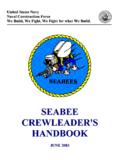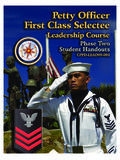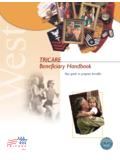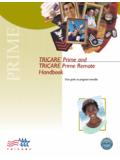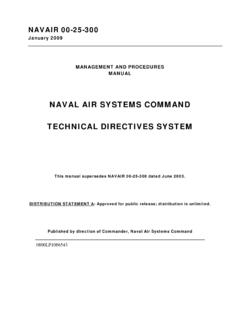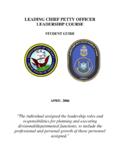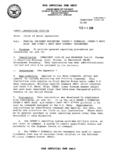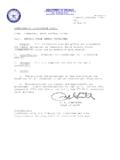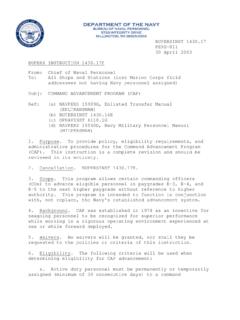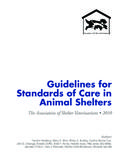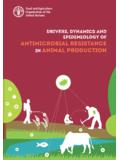Transcription of DEPARTMENT OF THE NAVY BUREAU OF MEDICINE …
1 DEPARTMENT OF THE NAVY. BUREAU OF MEDICINE AND surgery . 7700 arlington boulevard . FALLS church , VA 22042. IN REPLY REFER TO. BUMEDINST BUMED-M41. 28 Dec 2016. BUMED INSTRUCTION 6280. 1C. From: Chief, BUREAU of MEDICINE and surgery Subj: MANAGEMENT OF REGULATED MEDICAL WASTE. Ref: (a) 29 CFR Part (b) BUMEDINST (c) BUMEDINST (d) BUMEDINST (e) BUMEDINST (f) OPNAVINST (g) 49 CFR 100-185. (h) 40 CFR 60 and 62. Encl: (1) Requirements for Management of Regulated Medical Waste (2) Extracted Tooth Decision Tree 1. Purpose a. To provide standards for management of regulated medical waste (RMW) generated from processes at BUREAU of MEDICINE and surgery (BUMED) Budget Submitting Office (BSO) 18. facilities or received by BUMED facilities prior to treatment and disposal. RMW is often used interchangeably with infectious waste, biohazardous waste, and biomedical waste.
2 B. This instruction does not reflect regulatory variations found in many state or overseas jurisdictions. The user of this instruction must ascertain and adhere to applicable requirements that exceed the requirements of this instruction, including state and local requirements. In addition to this instruction, personnel conducting activities outside of the continental United States, Hawaii, Alaska, and its territories will adhere to their host nation Final Governing Standards (FGS) and, where a host nation FGS does not exist, the Overseas Environmental Baseline Guidance Document (OEBGD). In the event that variations in the requirements of this instruction and other regulatory requirements exist, the most stringent apply. c. The regulations provided in reference (a) and the policies in reference (b) describe the processes that BUMED facilities will implement to protect personnel from occupational exposures to blood and other potentially infectious material.
3 Pharmaceutical wastes and wastes generated in dental treatment spaces have additional considerations identified per references (c). and (d), respectively. Wastes generated from the management of biological select agents and toxins must be managed per reference (e). BUMEDINST 28 Dec 2016. d. This is a complete revision and must be read in its entirety. 2. Cancellation. BUMEDINST 3. Scope. This instruction applies to all BUMED BSO 18 facilities that generate RMW. These requirements also apply to Army Veterinary facilities aboard Navy shore installations per the established Memorandum of Agreement between BUMED and the United States Army Office of the Surgeon General of 20 February 2014. This instruction does not apply to personnel assigned to non-BUMED facilities unless the cognizant activity establishes a policy to adopt this instruction for its use.
4 Shipboard medical personnel are governed by the most current version of the Afloat Medical Waste Management Guide. Regulated medical wastes generated by non- BUMED facilities or received by non-BUMED facilities for management are governed by the requirements of reference (f). The Medical Officer of the Marine Corps provides separate guidance to Marine Corps activities. 4. Background. Reference (f) authorizes and instructs BUMED to develop and issue policy guidance for the disposition of dental, veterinary, medical, and pharmaceutical waste for BUMED facilities. The classification between non-RMW and RMW generated in the work space is critical for proper management of waste. a. Non-RMW is solid material intended for disposal which is produced as the direct result of non-infectious patient diagnosis, treatment, therapy, or medical research other than those characterized as RMW in enclosure (1).
5 Unless local requirements supersede this policy, examples include bandages containing very small amounts of blood or other body fluids, disposable catheters that may contain trace amounts of liquid, swabs, used disposable drapes, gowns, masks, and empty used specimen containers and urine cups. Non-RMW requires no further treatment and is disposed of as general waste and trash. b. RMW is generated during diagnosis, treatment, or immunization of humans or animals and is capable of causing disease or would pose other adverse health risks to individuals or the community if improperly handled. RMW is organized into nine groups that are managed based on associated risks, as identified in enclosures (1) and (2). 5. Action. Commanders, commanding officers, and officers-in-charge of BUMED facilities generating RMW must comply with applicable regulations or status of forces agreements regarding RMW and must ensure guidelines in this instruction are adopted and implemented accordingly.
6 6. Records Management. Records created as a result of this instruction, regardless of media and format, must be managed per SECNAV of January 2012. 2. BUMEDINST 6280. l C. 28 Dec 2016. 7. Review and Effective Date. Per reference (a), this instruction will be reviewed annually on the anniversary of its issuance date to ensure applicability, currency, and consistency with Federal, DoD, SECNAV and Navy policy, and statutory authority using OPNAV 5215/40. Review of Instruction. This instruction will automatically expire 5 years after its issuance date unless reissued or canceled prior to the 5-year anniversary date, or an extension has been granted. 8. Reports. The reports required in paragraphs 3d(4), and 4f(l)(c), are exempt from reports control per SECNAV of December 2005, part IV, paragraph 7k.
7 ~i.~. Acting Releasability and Distribution: This instruction is cleared for public release and is available electronically only via the Navy MEDICINE Web site: 3. BUMEDINST 28 Dec 2016. REQUIREMENTS FOR MANAGEMENT OF REGULATED MEDICAL WASTE. 1. Introduction. Workers in the healthcare setting must be protected from infectious exposures. This instruction works concurrently with references (a) and (b) to protect healthcare staff and others from exposures to blood-borne pathogens. This instruction does not reflect regulatory variations found in many state or overseas jurisdictions. The user of this instruction must ascertain and adhere to applicable requirements that exceed the requirements of this instruction. Personnel conducting activities OCONUS, Hawaii, Alaska, and its territories will adhere to their host nation FGS and, where an FGS does not exist, the OEBGD.
8 In the event that variations in the requirements of this instruction and those regulatory requirements exist, the most stringent must apply. There are nine primary groups of RMW, each with specific management, treatment, and disposal criteria: a. Group 1: Cultures, stocks, and vaccines b. Group 2: Pathological waste c. Group 3: Blood and blood products d. Group 4: Used sharps e. Group 5: Animal Waste (from animals exposed to infectious agents during research, production of biologicals, or testing of pharmaceuticals). f. Group 6: Isolation Wastes (including bedding from patients or animals from BioSafety Level 4 (BSL 4) agents). g. Group 7: Unused sharps h. Group 8: Other (including fluids that are designated by the local infection control authority). i. Group 9: Chemotherapy Trace Wastes 2.
9 Definitions a. Animal waste. This category is specific to infectious animals, contaminated animal carcasses, body parts, and bedding of animals known to have been exposed to infectious agents during treatment, research, productions of biologicals, or testing of pharmaceuticals. Other wastes generated from the treatment of non-infectious animals in the veterinary facilities are not included in this category; however, they are included in the other applicable RMW categories for management. Enclosure (1). BUMEDINST 28 Dec 2016. b. Bio Safety Level. There are four levels (1-4) with specific combination of work practices, safety equipment, and facilities, which are designed to minimize the exposure of workers and the environmental to infectious agents. Level 4 is the most stringent and applies for work with dangerous and exotic agents that pose a high individual risk of life threatening disease, which may be transmitted via the aerosol route and for which there is no available vaccine or therapy.
10 Also see paragraph 2g of this enclosure for isolation wastes. c. Blood and blood products. Free-flowing liquid human blood, plasma, serum, and other blood derivatives ( , blood in blood bags or bloody drainage in suction containers); absorbent materials soaked or dripping with blood; and items caked with dried blood, capable of releasing blood if handled. d. Cultures and stocks. Infectious agents and associated biologicals, including those from medical and pathological laboratories, as well as dishes and devices used to transfer, inoculate, and mix cultures. e. Dual waste. Waste that qualifies as both a RMW and hazardous waste (HW). Examples may include a syringe used to administer a medication that classifies as a pharmaceutical HW or dental amalgam waste. f. Hazardous Waste.
